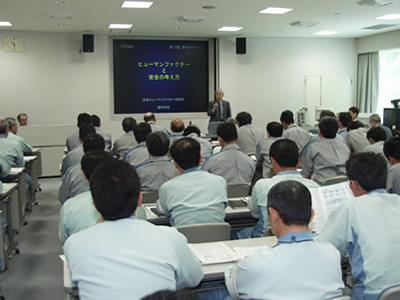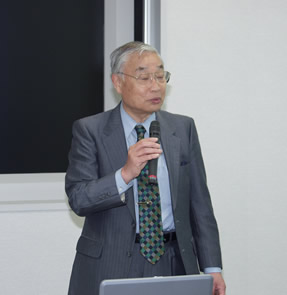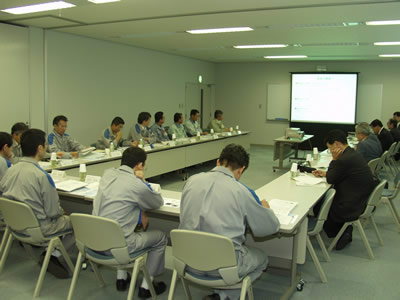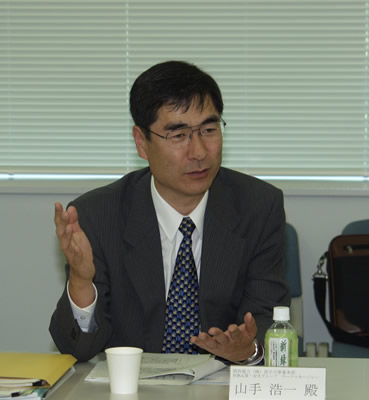|
|
 |
| On 13th May 2005, the 73rd Safety Caravan visited was held at Sendai Nuclear Power station, Kyusyu Electric Power Co., Ltd . located in Satsumasendai-shi Kagoshima Prefecture.
|
|
Safety Presentation |
About 75 persons, including the employees of Kyusyu Electric Power Co., Ltd and cooperating companies, attended the Safety Presentation
At the beginning of the presentation, Mr. Mamoru Dangami, Superintendent, Sendai Nuclear Power Station Kyusyu Electric Power Co., Ltd, gave an address and said, “This Safety Caravan at Sendai Nuclear Power Station today is a momentous occasion for the Japan Nuclear Technology Institute. At this power station, safety is a routine priority and whereas we have not had any major problems we think it is important to strive to decrease the human error close to zero as possible. I am looking forward to gaining much insight from the speech to be given by Mr. Watari who has great knowledge about facilities and quality assurance through working with JAL.
|

|
|
Safety Presentation
|
After the address, The Nuclear Safety Network Div. (NS Net) introduced the fundamental thinking behind the establishment and action policies of the Japan Nuclear Technology Institute and also explained the present activities of NS Net after which Mr. Kunihiro Watari, head of the Quality Assurance research Department at Japan Institute of Human Factors CO., LTD., gave a speech entitled,"Thinking about the Human Factor and Safety."
|

|
|
Mr. Watari
|
During the lecture Mr. Watari stated,
-Safety does not exist. What does exist is danger limits that society deems acceptable and when these danger limits are exceeded it is called an accident. The acceptable limits are vague and fluctuate with time and differ with respect to whether they are being looked at by an engineer or society.
-If he has no "knowledge" on safety, he cannot ensure safety. However, even if he has the knowledge, an accident will occur. He is required to be "conscious" of making use of the “knowledge.” Furthermore, safety is not accomplished until his safety "awareness" leads to safety "action."
-In thinking about safety it is necessary to know how humans process information. Humans have great ability to detect the input of information, but have very poor central processing skills and are only able to process one piece of information at a time. In addition, processing ability differs greatly depending on consciousness standards and mistakes are less likely to occur if we are alert to a certain extent. But, this state of alertness does not last long. For pilots it is called ‘the critical 11 minutes'. In other words, the 3 minutes during takeoff and the 8 minutes during landing are the times during which a pilot needs to be most alert
-In order to minimize the instance of error, it is necessary to recognize that humans do not set out planning to make mistakes, rather mistakes are a natural part of our actions.
-When we look at the structure of consecutive accidents we see that first there is a history of success followed by overconfidence, conceit and pride which plant the seeds of destruction. Then when the first accident occurs we think that it's a fluke and not a real problem. When the second accident occurs we think that it was due to a mistake by someone in the field and we try to save face within the company and reassure ourselves that there still is no problem. While publicly our response to the accident ends with passive measures formulated from the standpoint of cost and saving face in society. As this pattern repeats itself and accidents keep occurring, we start to feel that what is happening is not our responsibility and employees lose their sense of motivation which eventually leads to a large disaster. It is for this reason that the following is important.
(1) Throwing away your past honors, overconfidence and pride
(2) Changing failures (negative) into ways to prevent future occurrences (positive)
(3) Not passing the buck
(4) Building an environment in which opinions can be openly expressed regardless of position
(5) Making safety a company priority
|
Some comments on the questionnaire passed out after the speech noted, |
*I understand the importance of putting effort into safety and prevention. Even if it is a problem that occurred in another department I plan to treat it as if it was my problem too.
*It was a very valuable lecture. I plan to continue to put more energy into thinking about safety and prevention while keeping in mind that ‘people make mistakes' in hopes of preventing errors.
*The psychological factors related to human error were explained in a manner that was easy to understand. It was a very valuable lecture and included a lot of points that I would like to put into practice as someone in charge of human error prevention. |
Safety information exchange session |

|
|
Safety information exchange session
|
|

|
|
Mr. Khoichi Yamate
|
At the safety information exchange session, Mr. Khoichi Yamate, Chief Manager Nuclear Fuel Quality and Safety Group General Office Of Nuclear Power, The Kansai Electric Power Co., Inc., came and gave a detailed explanation about Issues and measures in the wake of the Mihama Unit 3 secondary piping rupture accident' at the request of Kyushu Electric Power Co., Inc.
Meanwhile, Mr. Takafumi Kawae, Technical Manager, from Sendai Nuclear Power Station, Kyushu Electric Power Co., Inc. introduced the safety culture building activities taking place at Kyushu Electric Power Co., Inc..
|
The main information and opinions exchanged included:
| ● |
When subcontracting, the power company should indicate the goals/background and policy in regards to the subcontracting. A confirmation of the work process and implementation of an inspection in regards to important matters should be carried out. |
| ● |
Effort should be put into writing the details on the specifications sheet. It is also necessary to improve communication between the power company and cooperative companies in order to avoid misunderstandings. |
| ● |
Management during specifications changes is especially important and it is necessary to make sure that information is adequately disseminated. |
|
In regards to the horizontal dissemination of necessary information,
| ● |
Of course the method is important but I think information will disseminate horizontally if each person recognizes what role their work plays in the overall picture and thinks about the effects on other plants. |
| ● |
Recognizing the need to prioritize safety must be the foundation for horizontal dissemination |
| ● |
A system is set up where the cooperation companies can offer suggestions to Kyushu Electric Power Co., Inc. This helps to make increase efficiency and effectiveness of the work done at the cooperating company as well. Both the electric power company and the cooperating companies are on the same page in terms of putting importance on their plant and many suggestions for regular inspections are being adopted. |
|
|
|
|







